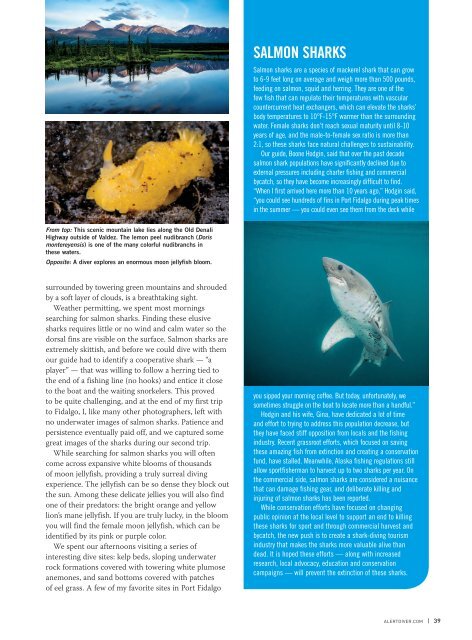AD 2017 Q4
Alert Diver is the dive industry’s leading publication. Featuring DAN’s core content of dive safety, research, education and medical information, each issue is a must-read reference, archived and shared by passionate scuba enthusiasts. In addition, Alert Diver showcases fascinating dive destinations and marine environmental topics through images from the world’s greatest underwater photographers and stories from the most experienced and eloquent dive journalists in the business.
Alert Diver is the dive industry’s leading publication. Featuring DAN’s core content of dive safety, research, education and medical information, each issue is a must-read reference, archived and shared by passionate scuba enthusiasts. In addition, Alert Diver showcases fascinating dive destinations and marine environmental topics through images from the world’s greatest underwater photographers and stories from the most experienced and eloquent dive journalists in the business.
Create successful ePaper yourself
Turn your PDF publications into a flip-book with our unique Google optimized e-Paper software.
SALMON SHARKS<br />
Salmon sharks are a species of mackerel shark that can grow<br />
to 6-9 feet long on average and weigh more than 500 pounds,<br />
feeding on salmon, squid and herring. They are one of the<br />
few fish that can regulate their temperatures with vascular<br />
countercurrent heat exchangers, which can elevate the sharks’<br />
body temperatures to 10°F-15°F warmer than the surrounding<br />
water. Female sharks don’t reach sexual maturity until 8-10<br />
years of age, and the male-to-female sex ratio is more than<br />
2:1, so these sharks face natural challenges to sustainability.<br />
Our guide, Boone Hodgin, said that over the past decade<br />
salmon shark populations have significantly declined due to<br />
external pressures including charter fishing and commercial<br />
bycatch, so they have become increasingly difficult to find.<br />
“When I first arrived here more than 10 years ago,” Hodgin said,<br />
“you could see hundreds of fins in Port Fidalgo during peak times<br />
in the summer — you could even see them from the deck while<br />
From top: This scenic mountain lake lies along the Old Denali<br />
Highway outside of Valdez. The lemon peel nudibranch (Doris<br />
montereyensis) is one of the many colorful nudibranchs in<br />
these waters.<br />
Opposite: A diver explores an enormous moon jellyfish bloom.<br />
surrounded by towering green mountains and shrouded<br />
by a soft layer of clouds, is a breathtaking sight.<br />
Weather permitting, we spent most mornings<br />
searching for salmon sharks. Finding these elusive<br />
sharks requires little or no wind and calm water so the<br />
dorsal fins are visible on the surface. Salmon sharks are<br />
extremely skittish, and before we could dive with them<br />
our guide had to identify a cooperative shark — “a<br />
player” — that was willing to follow a herring tied to<br />
the end of a fishing line (no hooks) and entice it close<br />
to the boat and the waiting snorkelers. This proved<br />
to be quite challenging, and at the end of my first trip<br />
to Fidalgo, I, like many other photographers, left with<br />
no underwater images of salmon sharks. Patience and<br />
persistence eventually paid off, and we captured some<br />
great images of the sharks during our second trip.<br />
While searching for salmon sharks you will often<br />
come across expansive white blooms of thousands<br />
of moon jellyfish, providing a truly surreal diving<br />
experience. The jellyfish can be so dense they block out<br />
the sun. Among these delicate jellies you will also find<br />
one of their predators: the bright orange and yellow<br />
lion’s mane jellyfish. If you are truly lucky, in the bloom<br />
you will find the female moon jellyfish, which can be<br />
identified by its pink or purple color.<br />
We spent our afternoons visiting a series of<br />
interesting dive sites: kelp beds, sloping underwater<br />
rock formations covered with towering white plumose<br />
anemones, and sand bottoms covered with patches<br />
of eel grass. A few of my favorite sites in Port Fidalgo<br />
you sipped your morning coffee. But today, unfortunately, we<br />
sometimes struggle on the boat to locate more than a handful.”<br />
Hodgin and his wife, Gina, have dedicated a lot of time<br />
and effort to trying to address this population decrease, but<br />
they have faced stiff opposition from locals and the fishing<br />
industry. Recent grassroot efforts, which focused on saving<br />
these amazing fish from extinction and creating a conservation<br />
fund, have stalled. Meanwhile, Alaska fishing regulations still<br />
allow sportfisherman to harvest up to two sharks per year. On<br />
the commercial side, salmon sharks are considered a nuisance<br />
that can damage fishing gear, and deliberate killing and<br />
injuring of salmon sharks has been reported.<br />
While conservation efforts have focused on changing<br />
public opinion at the local level to support an end to killing<br />
these sharks for sport and through commercial harvest and<br />
bycatch, the new push is to create a shark-diving tourism<br />
industry that makes the sharks more valuable alive than<br />
dead. It is hoped these efforts — along with increased<br />
research, local advocacy, education and conservation<br />
campaigns — will prevent the extinction of these sharks.<br />
ALERTDIVER.COM | 39









